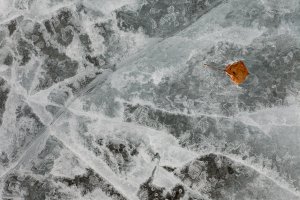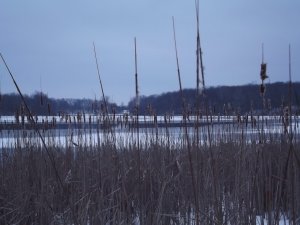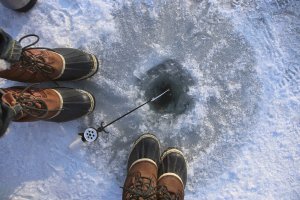Importance of Ice
February 15, 2023
Erin Parker, Interpretive Services Supervisor
Winter ice, covering our lakes, streams, and ponds, isn’t just a beautiful surface for skating and ice fishing. It serves an important role in the annual cycles of our freshwater ecology and all the plants and animals that live below the surface.

Properties of water
Water has a unique property when it approaches freezing (0 degrees Celsius, 32 degrees Fahrenheit). Water is densest at 4 degrees Celsius – it is less dense both above and below this temperature! This is critical in winter, because if water were densest at 0 degrees, where it also turns to solid ice, water in a pond or lake would freeze solid and sink to the bottom – slowly becoming one solid piece of ice and displacing everything that lives in the water!
Layers in the lake
Most of us can imagine jumping into a lake in the middle of the summer; the surface is warm, but the water gets much colder as we sink towards the bottom. This is called thermal stratification, where the water forms layers because of differing temperatures from top to bottom. The surface layer is warmed by the sun and gets churned and mixed by the wind. This adds oxygen into this top layer. During the summer, the coldest, densest layer is at the bottom. This layer typically becomes oxygen depleted during the summer. As sediments or organic material like leaves fall to the bottom, they are consumed by decomposers. These microorganisms use dissolved oxygen in the water and can bring it down to almost none! During the summer, as oxygen levels change, fish and other aquatic organisms can move between the layers.
As autumn temperatures start to cool the surface water, a little-known phenomenon occurs: lake turnover. The stratification that is present in both summer and winter vanishes as the surface water temperatures drop to match the bottom water. The surface water continues to cool down, eventually becoming colder and denser than the water at the bottom. The surface water sinks, bringing with it the oxygen mixed in by the wind. Meanwhile, the bottom water rises, bringing nutrients and sediments along with it. This mixing, happening in the fall and again as the winter warms into spring, helps to keep aquatic plants and animals alive.
In the winter, thermal stratification looks like that in the summer with one important difference. A layer of ice forms at 0°C at the surface, with a layer of 0°C water underneath that. The next layer is water between 0-4°C… remember, one of water’s unique properties is that it is densest AT 4°C! The dense layer of water at the bottom is 4°C. Water doesn’t mix here because the ice layer prevents it from happening. Aquatic life depends on the physics of water and ice- think about ice cubes floating in a drink instead of sinking to the bottom. If ice sank, it would crush plants and animals below it instead!
Ice impacts on aquatic life
The formation of ice at the surface helps protect the organisms below from winter storms and wind. Many fish find the coldest, still water at the bottom of lakes and ponds, and enter torpor, where they wait out the winter with slowed metabolisms where they don’t need to move, eat, or breathe as much as in their active states. Reptiles and amphibians may enter hibernation under the sediments beneath the water months before the ice forms, emerging with warm water and air in the spring. Many aquatic plants, like those above the surface, die back in an annual cycle and grow from roots, seeds, or tubers once the ice melts and sunlight can once again penetrate the water surface to allow photosynthesis.

Ice formation: changing patterns
Ice cover impacts evaporation levels which in turn impacts rain and snow. If the Great Lakes, for example, aren’t mostly ice-covered in the winter, wind moving across them can pick up more moisture which condenses into snow as that cold, wet air encounters cold, dry air over land. On our inland lakes, recreation opportunities such as ice fishing, skating, ice boating, and others become reduced and become more dangerous to participants. Ice cover should be a minimum of four inches thick before walking on them and even with cold air temperatures, it takes time for ice to form.

Data on the “ice on” and “ice off” dates for many lakes throughout the Great Lakes region, shows that ice cover is forming more than two weeks later than in the 1850s and breaking up earlier in the spring, too. How will this loss of ice impact the life cycles of aquatic organisms beneath the surface? Fewer days with ice causes warmer lake temperatures and more sunlight penetration beneath the waves. Both of these things encourage the growth of algae and aquatic plants. Many non-native and even toxic algal species are able to take advantage of this extra warmth and light. Warmer water temperatures on our inland and Great lakes can impact cold water fish species such as trout and can also contribute to fish die-offs.
Even seemingly small climate changes, such as ice cover being shorter by two weeks each year, can cause big impacts on ecology, water quality, and even recreation.
Resources:
